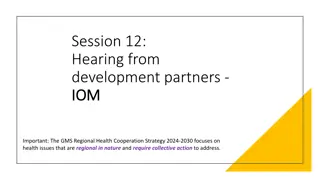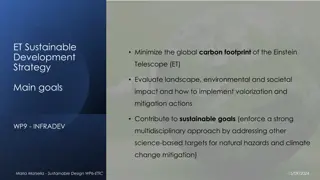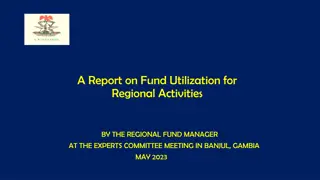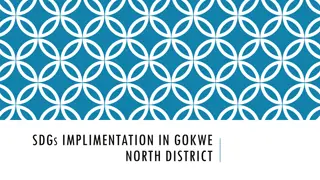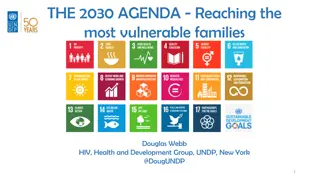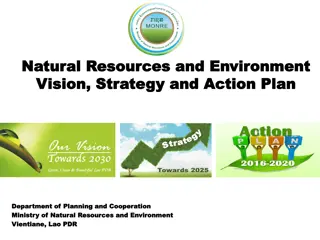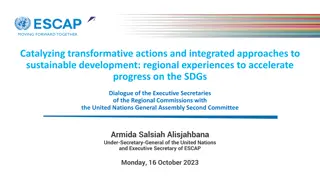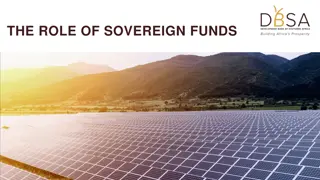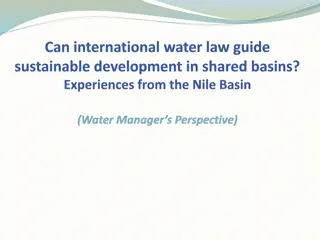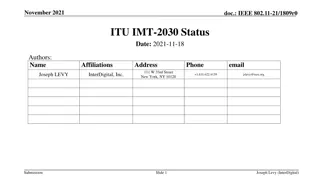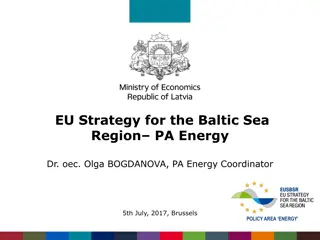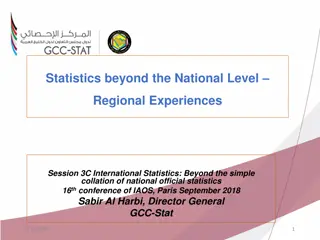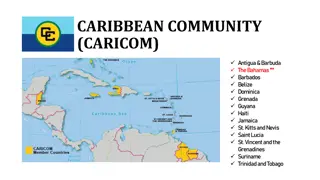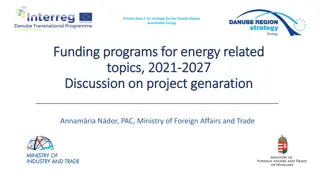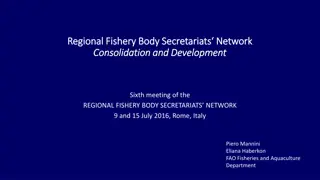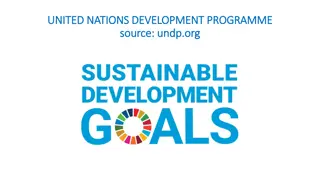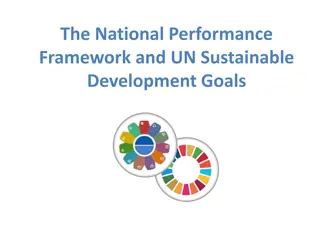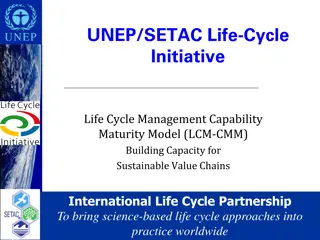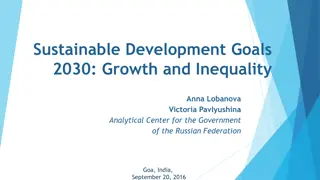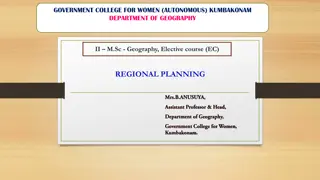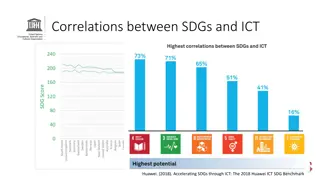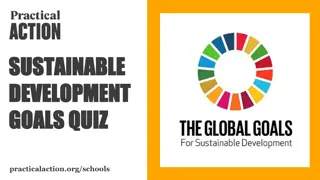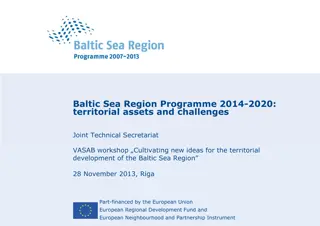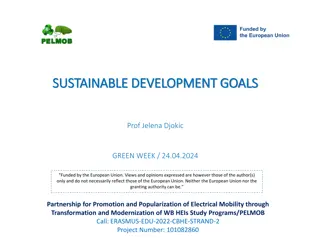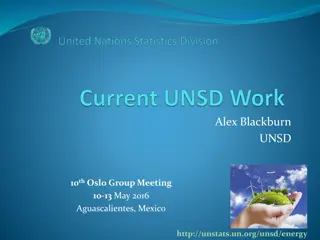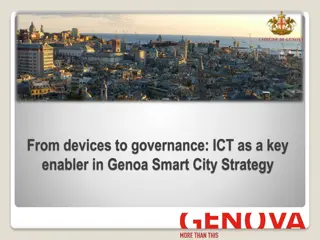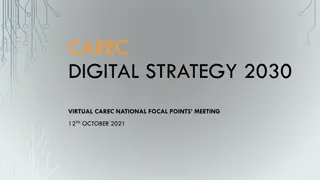The Val d'Aosta 2030 Strategy for Sustainable Regional Development
Promoting energy efficiency, reducing fossil fuel consumption, and advancing renewable energy sources are key goals of the Val d'Aosta 2030 strategy. Additionally, sustainable water resource management, enhancing territorial resilience, and addressing natural risks are highlighted priorities. The strategy aims to foster green initiatives, sustainable mobility, and integrated approaches to ensure a more environmentally friendly and prosperous future for the region.
Download Presentation

Please find below an Image/Link to download the presentation.
The content on the website is provided AS IS for your information and personal use only. It may not be sold, licensed, or shared on other websites without obtaining consent from the author. Download presentation by click this link. If you encounter any issues during the download, it is possible that the publisher has removed the file from their server.
E N D
Presentation Transcript
THE 2030 STRATEGY FOR THE VALLE DAOSTA SUSTAINABLE REGIONAL DEVELOPMENT, WHITHIN THE REGIONAL STRATEGIC FRAMEWORK (*) Extract with translation from the Chapter 2: Val d Aosta Green (edited by ILS LEDA) (*) https://svilupposostenibile.vda.it/Media/Svilupposostenibile/Hierarchy/18/1860/STRATEGIA%20DI%20 SVILUPPO%20SOSTENIBILE%20DELLA%20VALLE%20DAOSTA%202030-1.pdf
1. Energy and decarbonisation: fossil fuel free objective 2 Climate change for Water, and Air 3 Biodiversity 4 Landscape and territory 5 Waste and circular economy 6 Capitalization and diffusion of knowledge 7 Special Projects
Promote energy efficiency and reduction of cosumption from fossil fuels already mature technological solutions and recovery actions for energy waste and production waste innovative low carbon solutions with R&D specific attention to the civil energy sector reduction of needs for air conditioning and hot water production, public lighting systems, district heating plants Promote the production and use of energy from renewable sources Greater use of solar energy, and other renewable resources such as hydroelectric and biomass Production of sustainably produced hydrogen Promotion and support for self-consumption, with storage systems, through energetic communities and collective self- consumption systems Create the enabling conditions for the energy transition Involvement in the energy planning of local authorities, through the adoption of tools such as Action Plans for Sustainable Energy and Climate Promotion of energy communities Developing sustainable mobility Organizational review of local public transport Promotion of sustainable mobility Incentives for low carbon emission vehicles, both in the public and private sectors. Incentive for local services (co-working, telemedicine, teleassistance.
Promote more sustainable and integrated management of water resources Management and structural efficiency of the networks, from collection to purification, where necessary also through the creation of accumulation basins active policy for the management of surface and underground water resources aimed at guaranteeing the availability and quality of water for different uses, to encourage the reuse of the water resource and the separation of the same from waste water destined for sewer pipes Increase the resilience of the territory Effective governance of the issue of natural risks associated with the mountains, such as the sustainable management of forest and woodland areas and of the minor hydraulic network and of the agricultural sector in its various components (hydraulic and irrigation infrastructures, soil management,...) Expansion of the network of protected natural areas and the valorisation of the genetic resources most resilient to climate change. Monitoring of the quality of the urban environment based on the best European experiences Reduce emissions of polluting and climate-altering gases Improvement and strengthening of monitoring actions (with control units), Reduction of polluting emissions mainly attributable to the heating and vehicle sectors, Promotion of active mobility and public transport Expansion of district heating networks, heating systems based on renewable sources, such as heat pumps, production of electricity from renewable sources and methane transport networks
Implement a effective monitoring system Monitoring of regional biodiversity through the Regional Biodiversity Observatory, which allows you to view and download naturalistic data in the form of cards and maps, to report species of interest and to report invasive plant species. Develop the network of protected areas and the ecological continuity Moving from the protection and conservation of sites to the creation of the ecological network, to promote an interconnected system of habitats, based on the strengthening of connections and exchanges between areas and isolated natural elements, the Creation of the relevant cartography Promote ecosystem services Maintenance of traditional, extensive agricultural practices, linked to the typical productions of the area and maintenance of the mountain landscape. Mounting aids for the correct maintenance of mountain pasture areas, in contrast to the trend, which has emerged in recent decades, towards the intensification of farming in the valley bottom Funding for the transition to organic production methods and the adoption of environmental agro-climatic practices, aimed at reducing chemical inputs Support in moving from a corporate dimension to a territorial dimension through a collective approach. Maintain gene banks and conserve local varieties Ensure cryopreservation of hereditary genetic material - i.e. germplasm, in the form of seeds, spores, pollen or meristematic tissues, through the existing Plant Germplasm Bank In-depth knowledge of the biology and ecology of conserved species Promotion of programs to strengthen local populations and projects for the reintroduction of extinct species into nature; Raising awareness of society, and in particular schools, on the issues of plant biodiversity and its conservation.
Protect the landscape Promote traditional agricultural practices, consistently with the promotion of landscape ecosystem services, enhancing the action of farmers as custodians of the landscape, Enhance the interrelationships between the environment, agriculture and infrastructure Enhancement, including economic, of the regional territorial capital, through growing forms of sustainable tourism Contain land consumption Create a new vision of the soil as a common good and non-renewable resource, through actions to strengthen soil protection, contain building expansion, and regenerate urbanized territories Improvement of regulatory and planning tools at all levels, in a synergistic manner with the actions of the guidelines identified in the previous areas (Climate change, water and air and Biodiversity)
Promote the circular economy Strategy for the reuse, repair, reconditioning and recycling of existing materials and products, in order to extend their life cycle for as long as possible and reduce waste to a minimum Reduction of disposable plastic materials and the introduction of deposit - refund systems, agreements with large-scale distribution for the reduction of packaging and the introduction of the returnable vacuum policy Promotion of reuse centers and preparation for reuse Recovery of at least 70% of the waste deriving from construction and demolition operations, of excavated earth and rocks, with the use of construction material coming from recovery operations, the reuse of agricultural waste and the production of compost, the recovery sewage sludge and agricultural sewage Improve the management of municipal and special waste Achieve 60% of material recycling and 80% of separate waste collection by 2026, through transversal communication and awareness actions, the Payment of taxes based on undifferentiated waste produced Strengthening of municipal collection centers; the fight against food waste; encouraging domestic and community composting, activating the new flow of textiles at municipal collection centres; Creation of a plant aimed at closing the cycle of the organic fraction and the mechanical biological treatment plant Activation of collection points spread across the territory dedicated to the separate collection of waste produced by artisanal and agricultural businesses Clean up polluted areas Identification and depollution, remediation and environmental and landscape redevelopment of contaminated sites.
Expand and systematize knowledge Consolidate and strengthen the activity of the centers and networks of skills developed over the years at a regional level Establishment of a platform and a common management system to encourage the continuous expansion and improvement of monitoring capabilities (data collection, measurement and monitoring networks, ...), of data processing and modeling systems and of sharing opportunities across multidisciplinary level of information resources between different institutions and sectors. Implement monitoring and forecasting capacity Consolidate and improve, also from a technological point of view, monitoring capabilities and forecasting capabilities (modelling and scenario definition) on the effects of climate change (temperature and precipitation) on all environmental components (air, water, soil) and human activity most affected by these changes. Communicate and inform Communication and information that induce greater awareness and responsibility among people on nature, environmental and energy issues and challenges Promotion of the role of agriculture and the development of rural communities, for the prevention of hydrogeological risks and the valorisation of existing natural and human capital. Training and teaching Consolidation of the training system, aimed at the various components of civil society in order to increase knowledge and technical/professional skills and the adaptation of current skills for large segments of operators and production chains Creation in the territory of the necessary high-level skills in the field of sustainable development.
Main Objectives 1. Interdisciplinary scientific analysis of pastures 2. Adaptation measures 3. Capacity building of pastoral communities 4. Integrated strategic plan for adaptation 5. Tools to support decision-making processes
ADAPTATION MEASURES WITH RESPECT TO POSSIBLE RISKS DUE TO CLIMATE CHANGE RISKS ADAPTATION MEASURES Greater use of areas with consumable coarse or shrubby vegetation and food supplementation of lactating cows Reduction of animal load by reducing the number of animals mounted Reduction of animal load by delaying mounting Search for additional pastures and/or deforestation of the lower areas of the alpine pastures Recovery or construction of buildings and infrastructure in under-utilized grazing areas Search for temporary buffer zones outside the mountain pastures Early demonstration towards the end of the mountain pasture season Decreased quantity and quality of grass Instantaneous increase in load on productive pastures and food supplementation for lactating cows Advance payment (exceptional for one year or every year) Instantaneous increase in load on productive pastures and food supplementation for lactating cows Advance payment (exceptional for one year or every year) Reduction of grazing pressure on lower pastures by decreasing the period of use, compensated by increasing pressure in wooded areas Slower or later mounting Reduction of animal load by reducing the number of animals mounted Descent into the valley (demontication) of a portion of livestock during the season In case of recurring events: load reduction by reducing the number of animals mounted Storage of fodder reserves in the valley bottom, increasing hay production in marginal areas or purchasing hay Provision of fodder in the alpine pastures for lactating cows Restoration of pastures and construction or recovery of mountain pasture structures in new grazing areas. Recovery of medium mountain pastures (mayen Heat waves and wind at the early summer Descent into the valley (demontication) of a part of the animals during the season or early demolition of all the livestock Adaptation of the grazing circuit to water the animals Rationalization of water points on pastures Search for long-term sustainable supply solutions (drains, catchments, cisterns, troughs, etc.) Restoration of traditional irrigation systems and improvement of the efficiency of sprinkler irrigation Abandonment of a grazing area or early demolition Preparation of animals for grazing carried out systematically every year (hoof trimming, foot bath). Care and isolation of sick animals Favor areas where vegetation is sparse (or less tall) Heavy rainfall Careful and continuous maintenance of the water management network and roads (paths, slopes,...) Very mild autumn Delayed demotication Lack of snow, very dry winter (exposure to frost) or Early snow melt followed by spring frosts or Late or cold spring Early spring Drought in spring and little snow Very marked drought at the beginning of summer Increased instant load on productive pastures on areas with coarse vegetation and feed supplementation for lactating cows Very hot and dry summer, heatwave and drought Rainy summer


